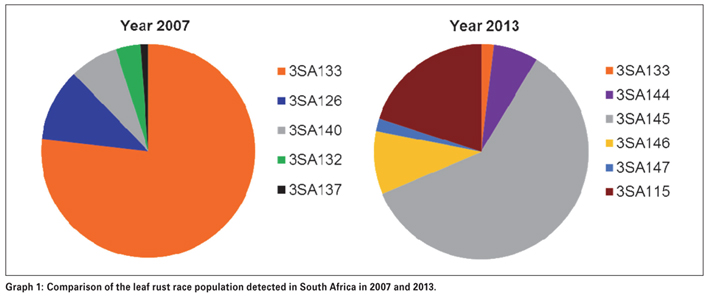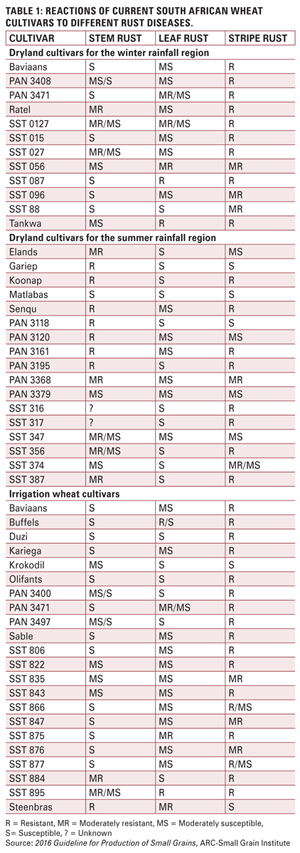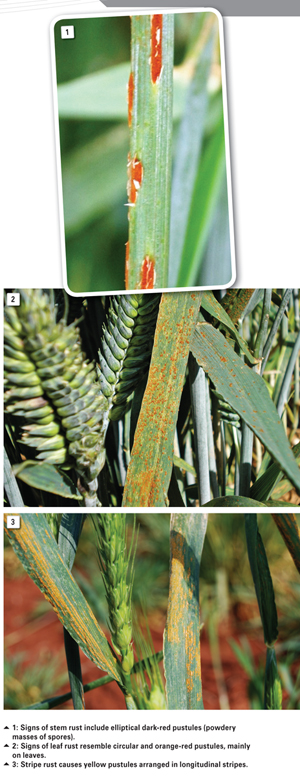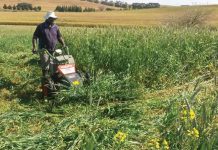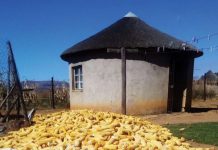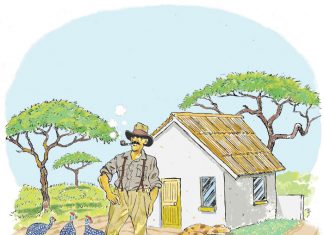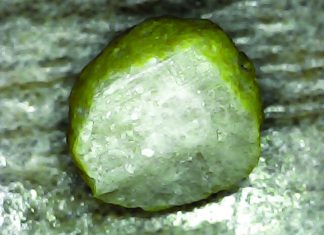September 2016
TAREKEGN TEREFE, ARC-Small Grain Institute, Bethlehem
Three types of rust diseases (stem rust, leaf rust and stripe rust) caused by fungi, commonly infect bread wheat in South Africa. These rusts can be easily distinguished based on visible signs on infected wheat plants.
Stem rust appears as elliptical dark-red pustules (powdery masses of spores) on the stem, leaf and sometimes on the head of wheat (Photo 1). Leaf rust primarily develops on wheat leaves as circular and orange-red pustules (Photo 2), while stripe rust signs include yellow pustules arranged in longitudinal stripes on the leaf (Photo 3), leaf sheath and occasionally on the head of wheat.
Stripe and leaf rust can cause extensive yield and quality loss, mainly by destroying leaves. Stem rust infection may weaken wheat stems, predisposing them to lodging. In addition, stem infection reduces nutrient flow to the head, thereby resulting in the development of small or shrivelled grains.
Environmental factors, primarily moisture and temperature, affect the prevalence and severity of wheat rusts. All three rusts require moisture (free water) for their spores to germinate and infect wheat. Stem and leaf rust are more common under warm weather conditions, but stripe rust mostly occurs under low temperature (10°C – 18°C) conditions. In South Africa, yellow rust is important in the cool-weather wheat production areas such as the eastern Free State, whereas stem and leaf rust are predominant in the warmer, moist wheat growing areas of the Western Cape.
Breeding for rust resistance
Resistant cultivars are often regarded as one of the most effective methods of wheat rust control. Unlike synthetic chemicals, they are environmentally safe, having no potential negative impact on biodiversity or on the health of producers, farm workers or consumers. In addition, genetic resistance can be easily integrated into other control methods. Resistance to rusts can be combined with resistance to other wheat diseases or insect pests.
Two kinds of resistance to wheat rusts are known: Race-specific and race-nonspecific resistance. Inheritance of race-specific resistance is mostly controlled by a single gene. Therefore, it is also referred to as single-gene resistance.
Race-nonspecific resistance is also called multi-gene resistance as it is controlled by more than one gene. Multi-gene resistance is quantitative and it is expressed as different degrees of resistance (disease levels). In contrast, single-gene resistance is expressed qualitatively, i.e. infected plants are either completely resistant or completely susceptible.
It is, therefore, easier to select plants with race-specific resistance. Consequently, race-specific resistance has been most commonly employed in breeding programmes, worldwide. However, singlegene resistance is prone to rapid breakdown with the emergence of a new rust strain (race), hence it is not durable. Multi-gene resistance is durable, because it remains effective regardless of the development of new rust races.
Virulence changes in rust fungi
Unfortunately, single-gene resistance is often short-lived due to the frequent development of new rust races with virulence to resistance genes contained in existing cultivars. More than 25 different races of leaf and stem rust and four races of stripe rust, have been identified in South Africa over the past three decades.
Graph 1 illustrates recent evolutionary changes that have occurred within the South African leaf rust population. In 2007, most of the isolates in the leaf rust population (about 77%) consisted of race 3SA133 and none of the isolates collected in that year were 3SA145 (Graph 1).
However, a few years later, the identity and frequency of leaf rust races have changed. Race 3SA145 was most commonly found (60%) in 2013.
In contrast, race 3SA133 became less common than it used to be, constituting only 2% of the population in 2013. Most of the races collected in 2013 were new and they were detected for the first time in South Africa during 2009 to 2012. From the five races detected in 2007, only 3SA133 was found in 2013.
These results have clearly shown the evolution of leaf rust populations in South Africa from 2007 to 2013. Similar changes have been recorded also for stripe and stem rust, suggesting that resistant cultivars protected by race-specific genes are vulnerable to infection by new races that could develop locally or migrate into the existing population from distant sources.
Rust monitoring helps in mitigating the negative impacts of frequently emerging new races by allowing early detection and control of such races.
Over the past 30 years, race surveys have been conducted in South Africa mainly by ARC-Small Grain Institute (ARC-SGI) and the results have contributed to sustainable breeding of rust resistant cultivars.
Given their extreme importance in resistance breeding, the ARC-SGI will continue conducting these surveys in the future. It is also important for wheat producers to monitor the status of their cultivars, particularly for changes from resistance to susceptibility, which suggests possible emergence of new races. Under such circumstances, infected samples can be sent to ARC-SGI for diagnosis.
Are there any rust resistant cultivars?
Over the past years, different wheat breeding companies in South Africa, including the ARC-SGI, have made concerted efforts to incorporate rust resistance into the wheat cultivars they release.
Table 1 shows the resistance status of cultivars currently recommended for different wheat production areas. Wheat producers need to select cultivars with the highest level of resistance against the commonly occurring rusts in their area. For example, there is a high risk of stripe rust infection in some areas of the summer rainfall dryland wheat production regions (e.g. Eastern Free State). Therefore, planting stripe rust susceptible cultivars in such areas should be avoided.
On the other hand, there is a low risk of leaf and stem rust infection in these regions and thus, even if a susceptible cultivar is planted, the risk of leaf or stem rust causing severe infection is significantly lower.
 In the Western Cape, leaf and stem rust are more important than stripe rust and therefore, cultivars resistant to these diseases should be chosen. When highly resistant cultivars are not available, one may consider planting moderately resistant or moderately susceptible cultivars.
In the Western Cape, leaf and stem rust are more important than stripe rust and therefore, cultivars resistant to these diseases should be chosen. When highly resistant cultivars are not available, one may consider planting moderately resistant or moderately susceptible cultivars.
Information on the resistance of wheat cultivars recommended for the summer and winter rainfall regions, is published annually by ARC-SGI in a booklet, entitled Small Grain Production Guideline. A copy of this booklet can be obtained from ARC-SGI.
Publication: September 2016
Section: Focus on



